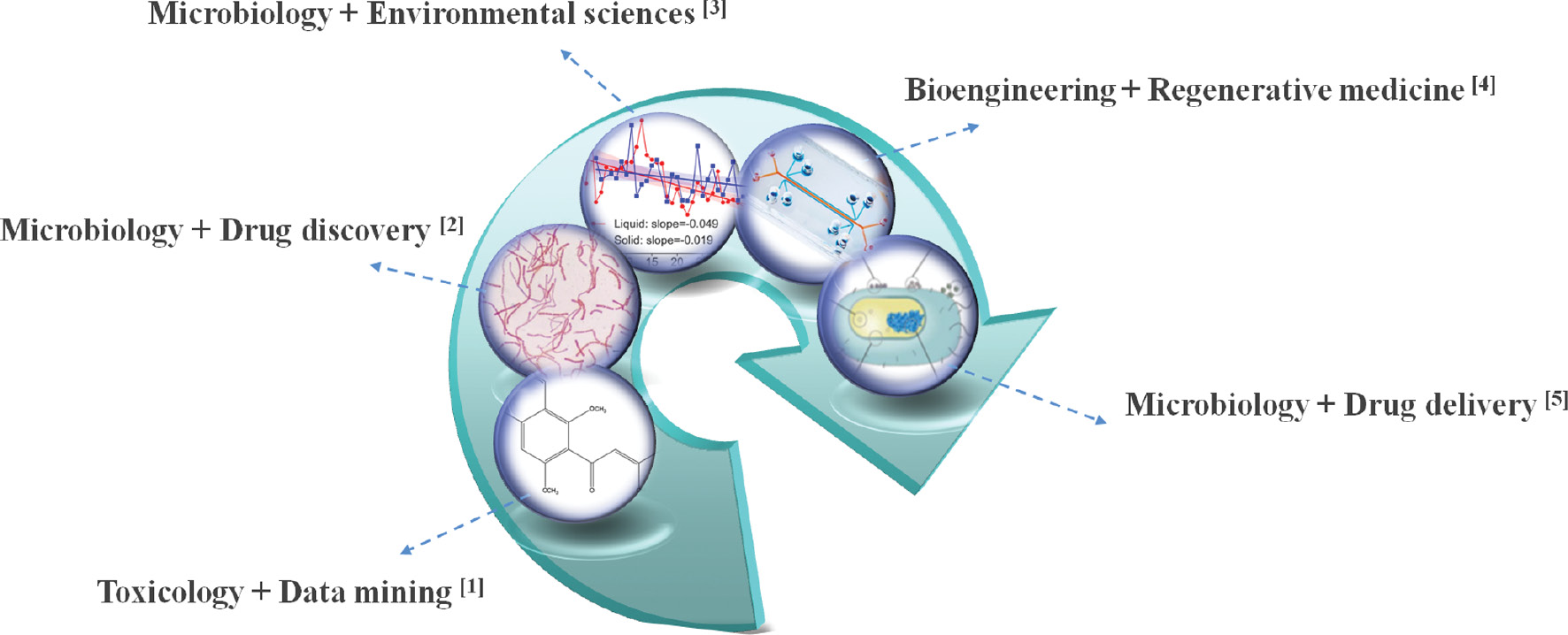Integration in Bioscience: Dynamic, Inclusive, and Full of Possibility
Published Online: January 18 2023
Cite this paper:
Chen Z. Integration in Bioscience: Dynamic, Inclusive, and Full of Possibility. BIO Integration 2023; 4(1): 1–2.
DOI: 10.15212/bioi-2023-0002. Available at: https://bio-integration.org/
Download citation
© 2023 The Authors. This is an open access article distributed under the terms of the Creative Commons Attribution License (https://creativecommons.org/licenses/by/4.0/). See https://bio-integration.org/copyright-and-permissions/
Dear colleagues,
In 2023, BIO Integration is entering our third year of publishing multidisciplinary viewpoints in bioscience. Our process remains the same: BIO Integration is an open-access journal focusing on original, cutting-edge, interdisciplinary content in the field of biosciences. In 2022, the journal focused on many aspects of integration in biomedicine (Figure 1). In a study conducted by Bezerra et al. at the Federal University of Ceará, web-based tools were integrated with pharmacokinetics to predict the pharmacokinetic and toxicological properties of lead flavonoids [1]. Focusing on the misuse of antibiotics and the discovery of novel antibacterial drugs, Geraldi et al. successfully isolated five bacillus species from the Parangkusumo coastal sand dunes and demonstrated their antimicrobial activity toward opportunistic pathogenic bacteria [2]. In the “Voice series” this year, Doris Yoong Wen Di shared advanced research results in COVID-19 detection during wastewater treatment, achieving highly successful integration of microbiology and environmental sciences [3]. In addition, a highlight of this volume was the special issue “Models and techniques in medical research,” which examined cutting-edge advances in experimental models or techniques associated with multiple disciplines, such as “organ-on-a-chip” [4] and bacteria-derived components for cancer immunotherapy [5]. We greatly appreciate these authors for choosing BIO Integration to share their valuable research results and experience in multidisciplinary integration. All the content can be found on the journal’s official website (https://bio-integration.org/). I hope you enjoy reading this interdisciplinary bioscience content.
Figure 1 Remarkable interdisciplinary integration of BIOI publications in 2022.
Although the development and trends in integration in bioscience are unpredictable and sometimes disruptive, we believe that their dynamic and inclusive nature will enable great possibilities. In December 2022, Nature published a list of “science events to watch for in 2023,” more than half of which are in the domain of integrative bioscience [6]. For example, in Alzheimer disease (AD) research, one event is monoclonal antibody treatments, such as lecanemab (developed by Eisai and Biogen) and blarcamesine (developed by Anavex Life Sciences) [7]. Drugs for AD were a controversial topic in 2022, and the foundational hypothesis suggesting that Aβ plaques are the primary cause of AD, published in 2006, was questioned because of possible scientific misconduct [8]. Many problems have been noted, including the therapeutic effect of aducanumab, a monoclonal-antibody-based treatment reported to decrease the amyloid-plaque load in the brains of patients with AD. In Volume 3 of BIO Integration, Wei-Jye Lin and Stephen R. Salton objectively discussed the approval of aducanumab by the US Food and Drug Administration, as well as its controversial clinical outcomes. In their opinion, although controversial, the approval of aducanumab is a positive sign for AD research, because it has encouraged further investment in developing new therapeutic strategies for AD [9].
Finally, it is my pleasure to report the journal’s efforts in driving progress in modern medicine and integrative bioscience in the past year. In 2022, the journal published more than 25 high-quality peer-reviewed manuscripts online. We are pleased to see that researchers are increasingly willing to share their original studies through the interdisciplinary forum of our journal. Citations to articles published in BIO Integration have steadily increased in the past 3 years. A major step was the journal’s indexing by SCOPUS, one of the largest databases of peer-reviewed scientific information. We are proud of the achievements of BIO Integration, and we would like to thank our authors, readers, editors, and reviewers, whose hard work and dedication have been instrumental in our journal’s development. We welcome every submission and suggestion to help improve our principles and practices, and we are grateful for the opportunity to contribute to advancing science. The journal’s future depends on continuing support from the interdisciplinary integration community. We hope that BIO Integration will receive consistent support from our readers, authors, editors, and reviewers in the coming years. Together, we can bring BIO Integration to new heights.
Yours sincerely,
Zhiyi Chen
References
- Rogério MEF, Chaves HV, Pinto IR, de Sousa NA, Ribeiro KA, et al. ADME-tox prediction and molecular docking studies of two lead flavonoids from the roots of tephrosia egregia sandw and the gastroprotective effects of its root extract in mice. BIO Integration 2022;3(2):43-52. [DOI: 10.15212/bioi-2021-0035]
- Geraldi A, Famunghui M, Abigail M, Siona Saragih CF, Febitania D, et al. Screening of antibacterial activities of Bacillus spp. isolated from the Parangkusumo coastal sand dunes, Indonesia. BIO Integration 2022;3(3):132-7. [DOI: 10.15212/bioi-2022-0005]
- Saw PE. Voice series: Interview with Dr. Doris Di, University of Hawaii at Manoa; frontier in COVID-19 detection from wastewater treatment. BIO Integration 2022;3(3):138-41. [DOI: 10.15212/bioi-2022-0012]
- Victorious A. Current applications of organ-on-a-chip: a step closer to personalized medicine. BIO Integration 2022;3(4):143-50. [DOI: 10.15212/bioi-2022-0027]
- Zhang C, Mu Y, Zhuo Y, Li T, Jin FJ, et al. Utilizing bacteria-derived components for cancer immunotherapy. BIO Integration 2022;3(4):180-7. [DOI: 10.15212/bioi-2022-0022]
- Naddaf M. The science events to watch for in 2023. Nature 2023;613:11-2. [DOI: 10.1038/d41586-022-04444-3]
- van Dyck CH, Swanson CJ, Aisen P, Bateman RJ, Chen C, et al. Lecanemab in early Alzheimer’s disease. N Engl J Med 2023;388:9-21. [DOI: 10.1056/NEJMoa2212948]
- Piller C. Blots on a field? Science 2022;377(6604):358-63. [PMID: 35862524 DOI: 10.1126/science.add9993]
- Lin WJ, Xiao C, Salton SR. Hope or hype? Aducanumab as a magic bullet for Alzheimer’s disease. BIO Integration 2022;3(2):84-8. [DOI: 10.15212/bioi-2021-0034]

